Blogs
Practical Insights & Latest Happenings
Don’t miss out on the latest trends and info on SEO, search engines, social media, and more.
October 26, 2023
mothasim
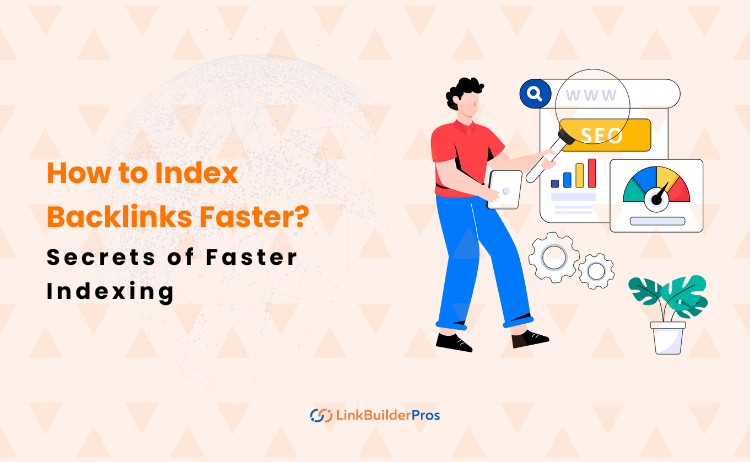
If you are wondering about how to index backlinks, that means you have gained some new links and waited a few days but you cannot find them on Google yet. It’s getting frustrating day by day, isn’t it?
Fret not, we are here to help! We have cracked the indexing code and figured out the fastest ways to index backlinks. Some methods are free while some tools charge a small amount.
However, you don’t need to follow all the tactics. Try one out first and wait a couple of days to see if it works. If not then head to another.
The answer is both yes and no. Google is supposed to index your backlinks naturally within its own timeline. So, after gaining new links, you have to hold tight until they show up on Google.
However, if you don’t see anything happening within 10 days, there are some ways to speed up the process. At this point, you need to take matters into your own hands because otherwise your precious links might be left untouched by search engines and you won’t get any benefits from your link building campaign.
Disclaimer: There is no guarantee that these methods will work as per your expectations because Google doesn’t have any official guidelines. However, many SEO specialists and industry experts have followed them and found effective results.
Technically, search engines don’t index backlinks; instead, their bots crawl and index web pages that contain your inbound links. So, our purpose is to notify these bots to visit the source pages within a short time using different tools and procedures.
It means creating inbound links for your backlinks. For example, if you get a link from Site A (Tier 1), then you are going to acquire another link from Site B (Tier 2) pointing to Site A and earn one more from Site C (Tier 3) linking to Site B.
The goal is to pass link juice from one Tier to another and finally to your main site. Here, we will use the same process but for a different purpose – to index your links faster.
In your case, you want to know how to index backlinks. That means these are your Tier 1 links and we will build Tier 2 backlinks so Google is notified about Tier 1 and then create Tier 3 links to inform Google of Tier 2.
Sounds complicated? Let’s break it down for you.
1-A: Add Your Backlink to Another Guest Post (Tier 2)
Although there are different types of web pages, blogs or articles have the highest percentage of indexing ratio because Google bots constantly crawl blog posts for new and updated content.
You have to find niche-relevant and high-authority sites that accept guest posts. Make sure they post new content regularly and have some traffic. Also, Google those domains to see how many indexed posts they have.
Suppose your targeted site has 500 pieces of content but Google shows only 100 and most of them are older posts. That means it has an indexing issue and you should avoid it. The ideal site should have a 100/100 post-to-index ratio.
If it is a large site, at least 80% of the posts should be indexed. However, if you can’t compare, just check to see that Google shows recent articles on this site.
For instance, if Forbes.com is your target site, Google: site:https://www.forbes.com/
Usually, they allow you to include 2 external links for your sites and additional 1-2 pointing to well-established resources as citations.
If they agree to feature your content, follow the steps below.
Step 1: Write an informative and SEO-optimized article.
Step 2: Insert one link to your money site (main website) and another to the Tier 1.
Step 3: Also add some relevant external links to reputable sources like Wikipedia or Forbes.
Step 4: Forward your content to the web admin and request them to fetch it to Google using Search Console’s URL Inspection tool after they publish it.
If Google indexes this article, it will catch up with your Tier 1 link too. This is the best white hat SEO tactic so far to index backlinks.
Didn’t work for you? Let’s check another effective way to know how to index backlinks.
1-B: Use Web 2.0 (Tier 2)
Web 2.0 sites refer to free blogging platforms, forums, social media, and wikis where users can directly interact with and create content for the platforms. You have to create a free blog site that will help you index your inbound links.
Blogger.com is our first choice because Google shows a 1.9M+ index for this domain. Also, Google owns this platform, which is our biggest advantage.
Follow the steps below and build an optimized Web 2.0 site.
Step 1: Go to Blogger.com and click “CREATE YOUR BLOG.” Sign in using your Gmail account. (If you don’t have a Google account, click the “Create account” option and make one.)
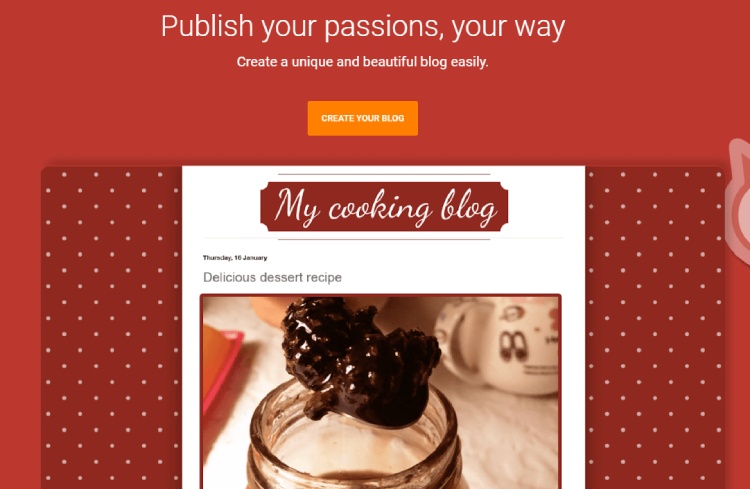
Step 2: Choose a title and a unique URL for your domain. (It’s a free platform and your blog will be a sub-domain of Blogger with an extension – blogspot.com.)

Step 3: Set an elegant theme matching your niche.
Step 4: Publish a few articles in micro-niche and add different pages like About, Privacy Policy, and Contact info.
Step 5:
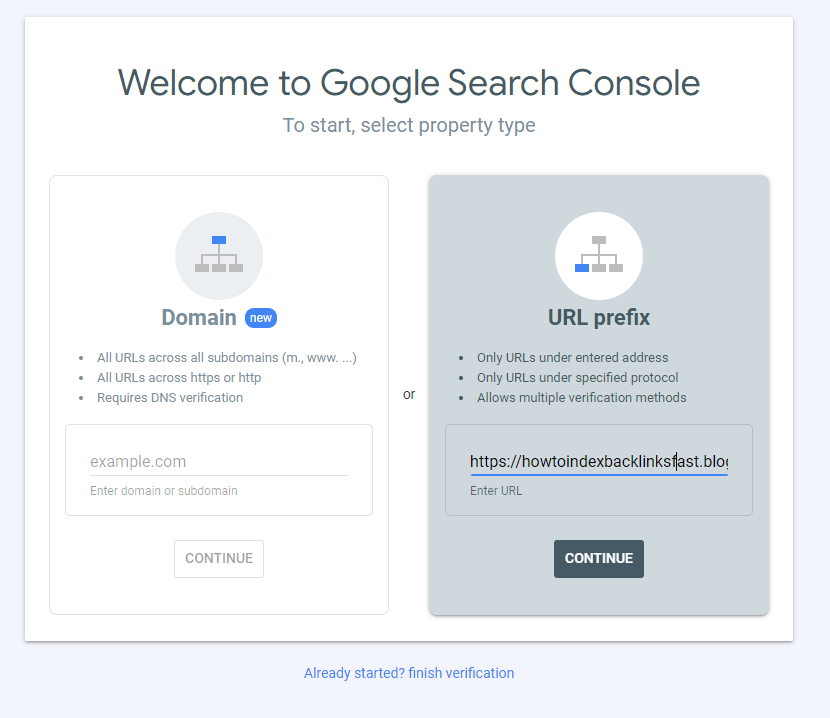
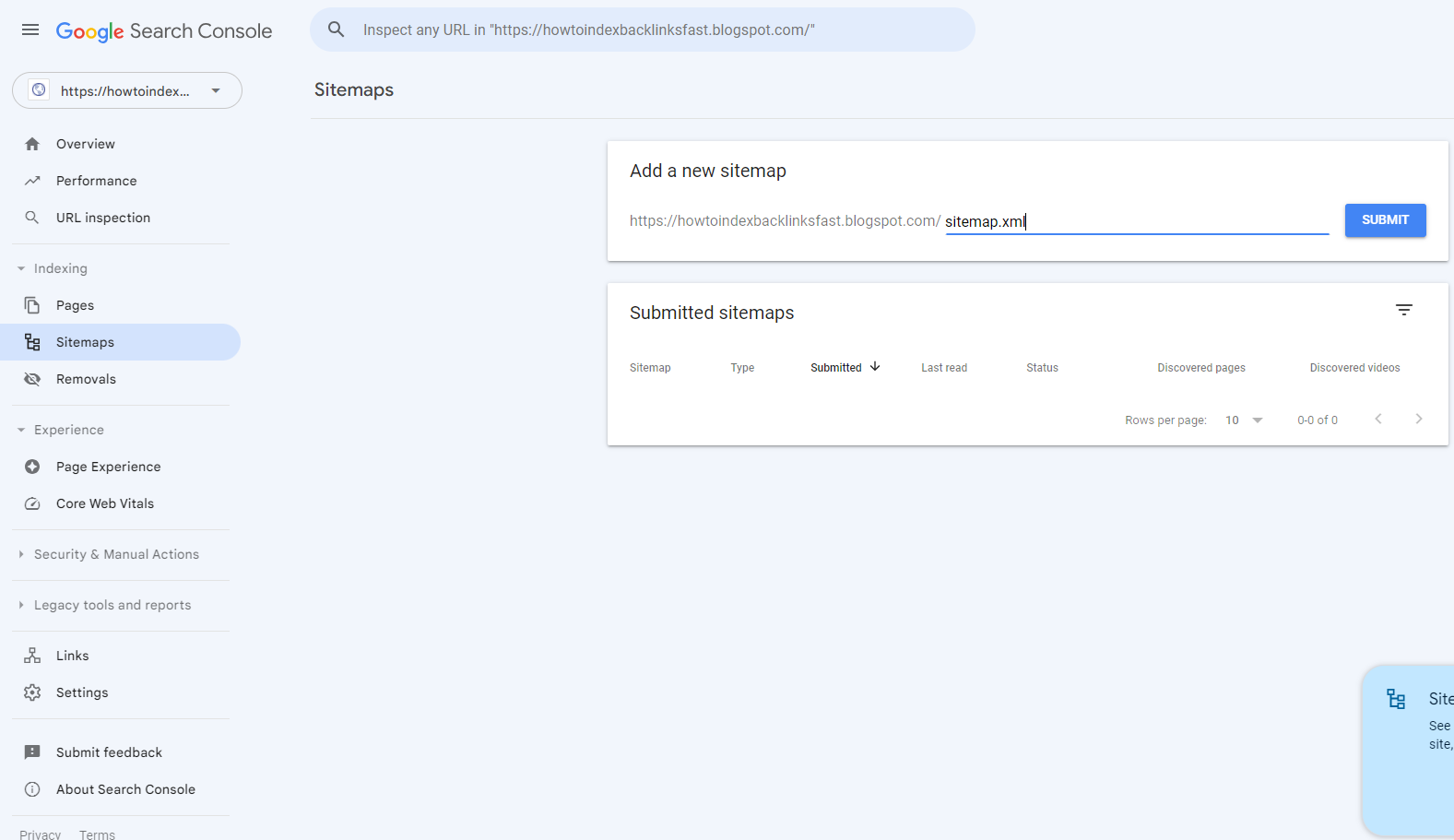
Step 6: Wait a few days for Google to crawl and display your site data on GSC.
Step 7: Write some SEO-optimized and keyword-rich content ranging from 800 to 1000 words with the necessary SEO title, meta des, and header tags.
Step 8: Insert your Tier 1 backlink in the body along with additional external links to authority sources. You can add 2-3 links for a 1000-word article. Also, don’t forget to link to the other content on the site (internal linking).
Step 9: Publish and share it on social media.
Step 10:
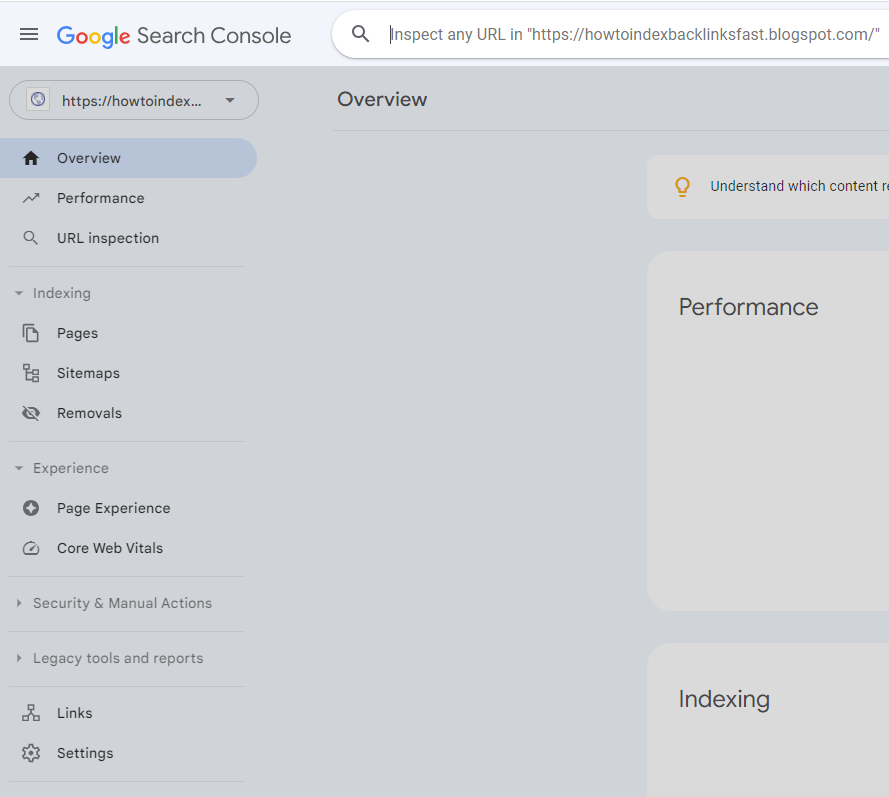
Wait a few days and see how the magic happens.
We have shown you one example with Blogger.com. You can do the same with other Web 2.0 sites.
Here are some popular platforms with a high Domain Authority (DA) rating:
Still wondering how to index backlinks on Google? Here is another trick we have under our sleeve!
1-C: Link from Content Sharing Platforms (Tier 2)
The internet has some mega communities, discussion boards, Q&A sites, and forums with millions of active members. People are giving answers and sharing their opinions, on these platforms in the form of links, texts, images, and videos.
Search engines also prioritize content-sharing sites. For instance, now in 2023, Reddit has 198M+ indexed posts while Quora has 185M+.
That means their post-to-index ratios are high. If you can manage to get links from such sites, there will be higher chances of Google crawling your links sooner.
How do you index backlinks faster using Reddit or Quora?
Reddit is famous for content rating, discussing trending topics, and news aggregating. It won’t work if you just create an account and post your link. Instead, you have to participate in niche-related discussions and build relationships with other Redditors.
You can also share viral news and events from popular newspapers. Don’t forget to leave comments on and upvote other users’ posts.
All of this will help increase your Reddit karma – a score that represents how much you have contributed to the community. The more scores you can earn, the more Reddit will trust you.
When you have enough karma, you can post the URLs of the web pages that contain your backlinks (Tier 1). You can also share your Tier 2 links – guest posts and the blog site to speed up their indexing process, which will ultimately signal Google to notice your main backlinks (Tier 1).
On the other hand, Quora works in a little different way. You can create a profile, answer other user’s questions, and publish articles.
How to index backlinks with Quora? Here’s your guide:
If you search “What are the basic steps to start a blog?” on Quora, you will find this result:
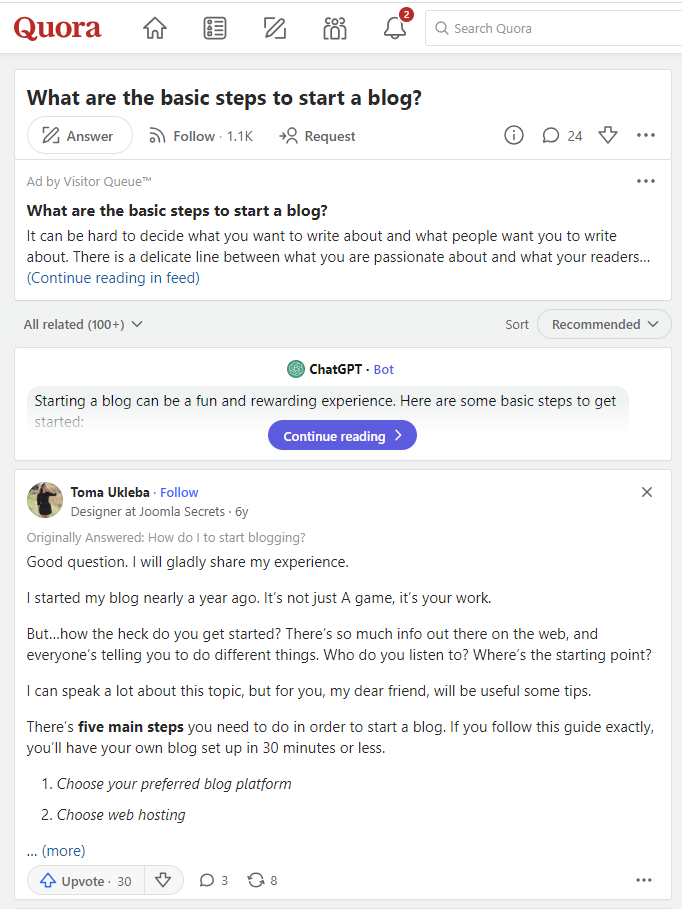
Now the question is, did Google crawl this page and index it? Yes because a further search shows this:
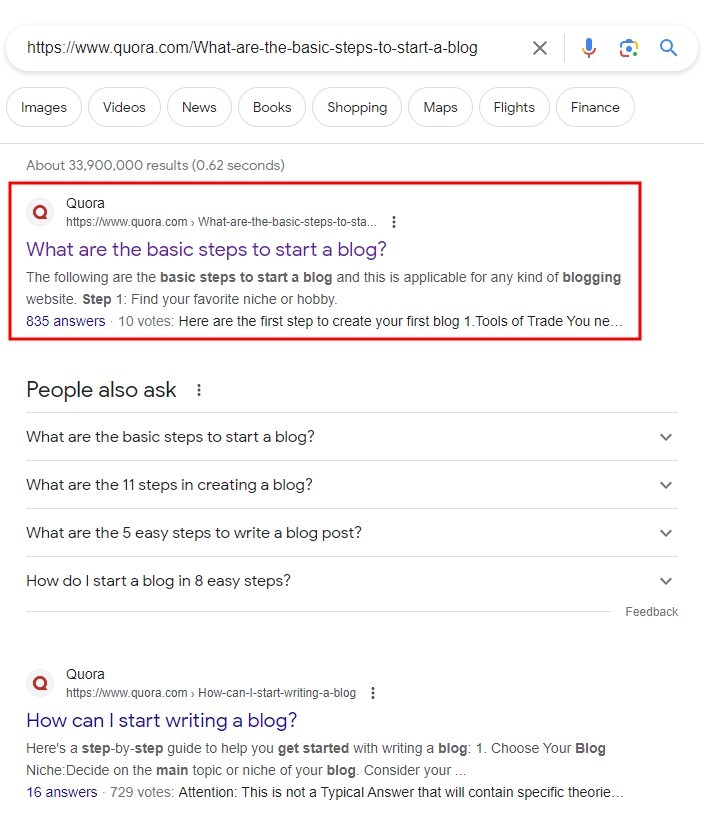
Did you notice there were 800+ answers? That means Google indexed not only the question but also all those answers.
Let’s go back to our example on Quora.
If you scroll down, you will notice an answer from a user named “Harshit Arora.” He posted a long-form reply that covered every aspect of the question.
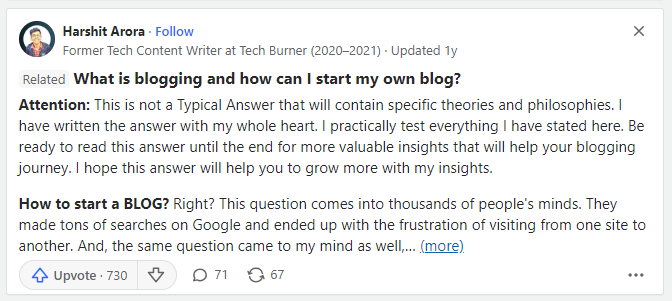
Look into his conclusion. Did you notice how he added his blog link?

Also, if you check his profile link, you will find that Google indexed it as well.
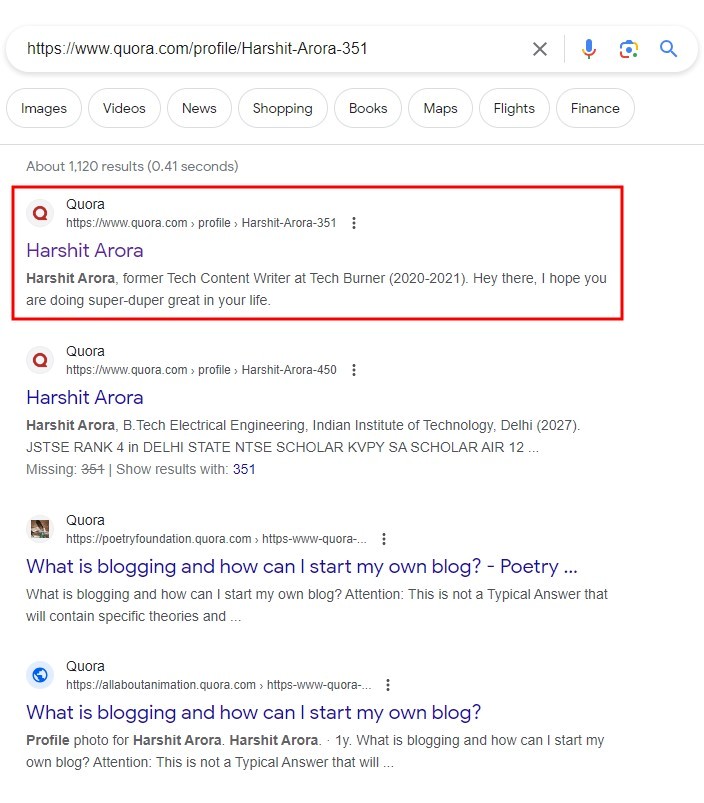
This is your golden ticket to index your incoming link.
Here is how:
Step 1: Create an account on Quora using your Gmail ID and password.
Step 2: Add the Tier 2 Blog link to your profile like this:
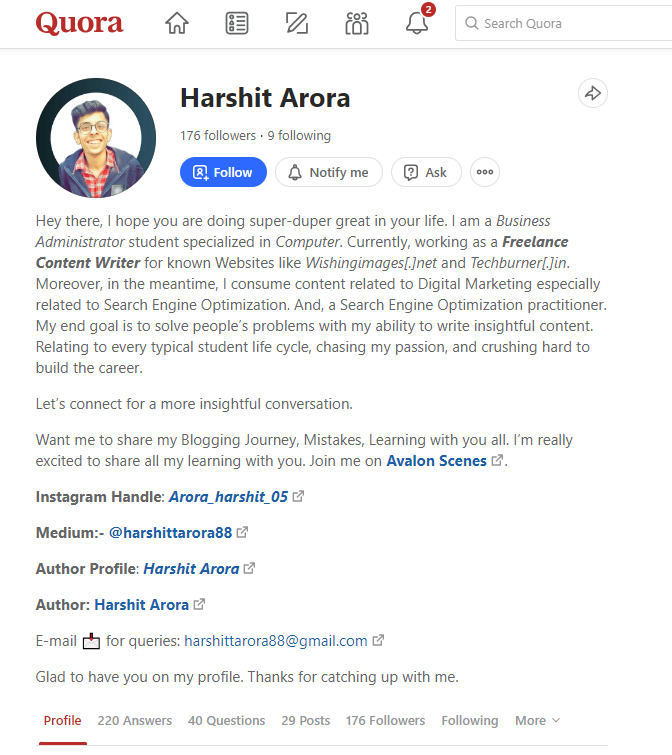
Step 3: Look for popular niche-related posts that have the recent answers and most importantly are indexed on Google.
Step 4: Reply with long-form answers with links to the web pages that contain your Tier 1 backlinks.
Note: Most User Generated Content (UGC) platforms offer nofollow external links. Don’t worry about the link attributes because next time when Google crawls your answer on Quora, it will read your link, too.
There was a time when you published a content, fetched it to Google, shared it on several social media platforms, and voila, search engines indexed it within a few hours.
At that time, Google prioritized social posts and even ranked them for numerous keywords. But that time is long gone. Nowadays, you barely see Twitter or Facebook posts on top SERPs.
However, you can still use them to index your newly gained incoming links. Here’s how it’s done.
Let’s say you have active profiles on the top five social media platforms – Facebook, Twitter, LinkedIn, Pinterest, and Instagram – with a good follower base.
You share engaging posts and other niche-relevant content from different sources. Also, you talk about your industry and participate in communities to establish your authority.
Over time, you have grown your profiles and followers. As a result, both the social platforms and Google consider you as an authority in your niche.
If you share an article that contains your backlink and your followers like it, they may check it out on your site. The more social traffic you can drive to your site, the higher the chance that Google will index the content and the links.
So, share your links on as many social platforms as you can to boost your social signals – likes, shares, and comments.
LinkedIn is another top choice. Google doesn’t index LinkedIn posts but you will see content from LinkedIn Pulse on search results – 39.5M+ posts.
Note: The Pulse is LinkedIn’s content distribution platform that allows users to write, publish, and share articles.
For example, if you search “How many backlinks do I have?” on Google, this is what you get:
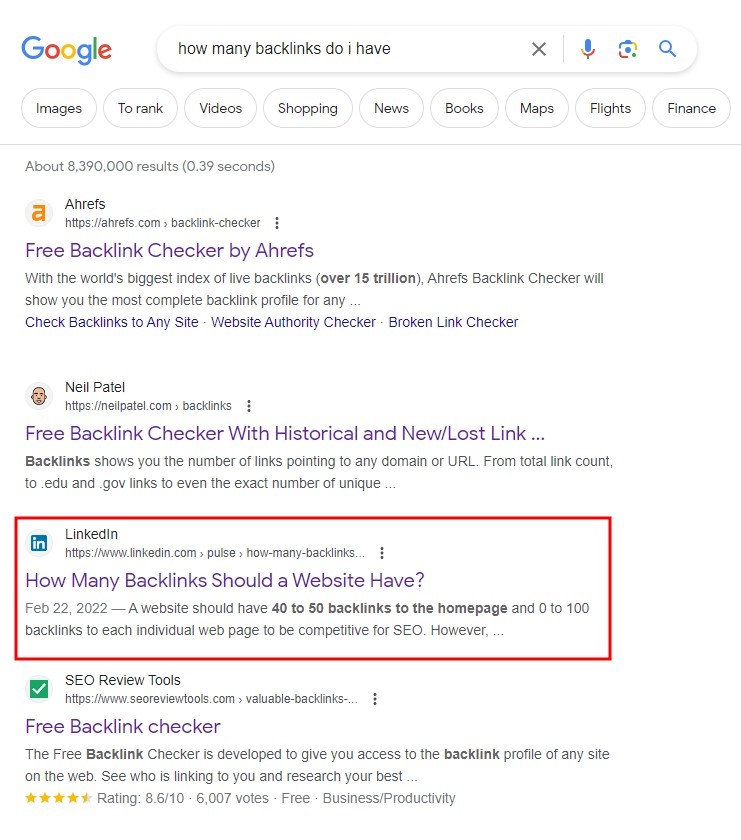
Did you notice a LinkedIn Pulse blog holds the #3 position?
Well, you can turn this opportunity in your favor too! Follow the steps below.
Step 1: Sign up for LinkedIn and create your profile.
Step 2: Navigate to the “Home” page and click the “Write article” button.

Step 3: Create content and add your backlink.
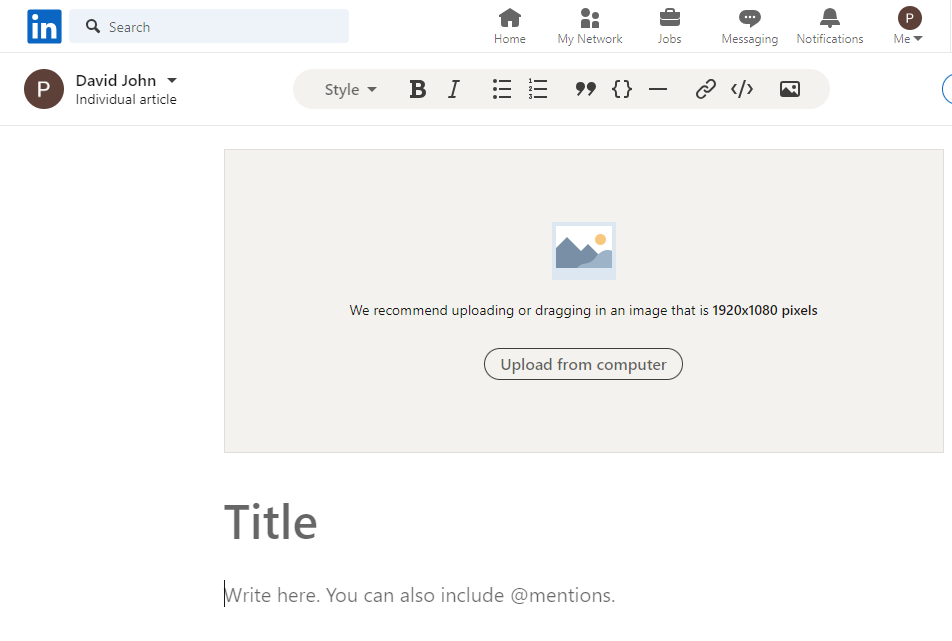
Step 4: Publish and share in your feed.
Step 5: Forward the link to your connections.
You can use this platform as a Tier 2 link. Similar to guest posts and Web 2.0, when the Google bots come to visit your Pulse, they will find your backlink too.
You have probably noticed that many videos now show up on SERPs, especially for “How to” type keywords.
In 2023, Google shows 1.62B+ results for YouTube, which indicates how well videos are ranked.
The question is – how to index backlinks with YouTube?
You have to create some short videos and reels with keyword-rich titles and descriptions.
For example, if you Google “how to get backlinks,” you will get this result:
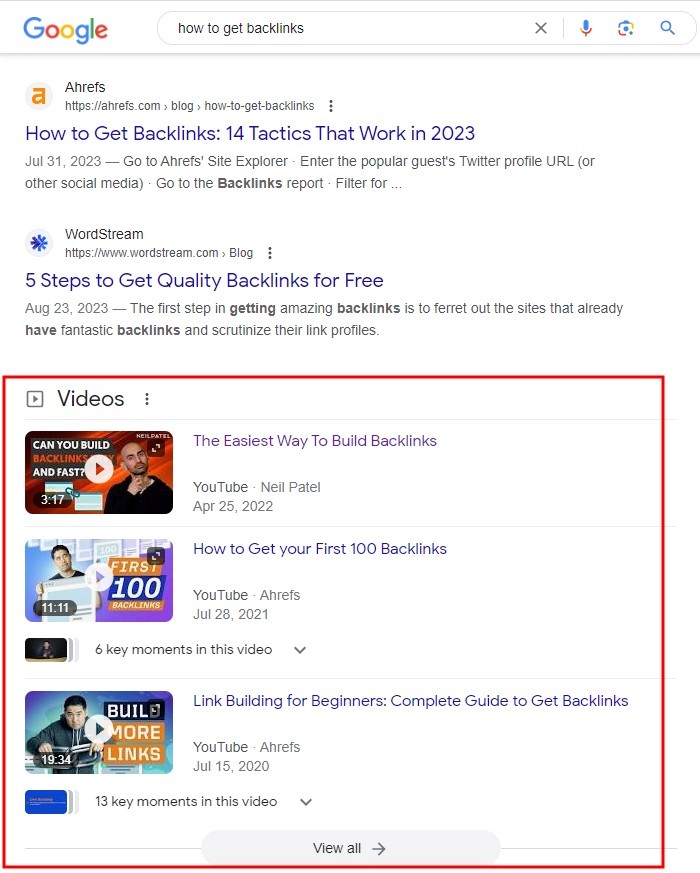
If you check the description of the first video, you will see Neil Patel – an online marketing guru – wrote a long-form description with two links.
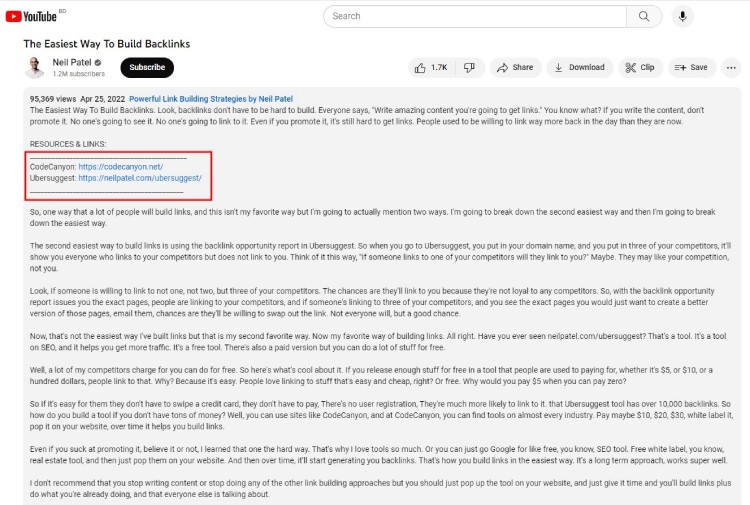
The links are obviously nofollow. But can you imagine how much impact your video will have on the backlink where Google not only indexes but also ranks it?
Follow the steps below and let Google find your links quickly.
Step 1: Sign in to YouTube using a Gmail account.
Step 2: Create a “How to” or tutorial video in your niche using a free video editing software like Shotcut, iMovie, OpenShot, or Movavi.
Step 3: Add your keywords to the title and write a detailed description with your backlinks (Tier 1). You can also include your main site and even Tier 2 links.
Step 4: If you are up for more videos, try adding internal links in the descriptions.
Step 5: Publish the video and share it on your social channels.
Step 6: You can also embed videos in your relevant Tier 2 blogs – Blogger.com so Google can crawl from one link to another easily.
Until now, we have shown you different tactics that require content publishing and sharing on different social platforms to index your incoming links.
If none of them work for you, try the following methods to inform search engines of your backlinks directly. You will need some tools for these ones.
Let’s find out how to index backlinks using ping and indexer tools.
In the world of SEO, pinging is the process of automatically notifying search engines about an update on a web page.
Many tools can ping your link to 50 – 100 search engines, including the top ones like Google, Yahoo, Bing, and Yandex. They send signals in real-time; i.e., your URL will be pinged within a few seconds.
Ping-O-Matic is our all-time favorite free tool. Here’s how to go about the process:
Step 1: Visit Ping-O-Matic.
Step 2: Type the article title that contains your backlink.
Step 3: Copy/paste the URL (Article URL, not that of the backlink.)
Step 4: Copy/paste the RSS Feed. (If you don’t know it, don’t bother because it is optional.)
Step 5: Select all services and click the “Send Pings” button. That’s it.
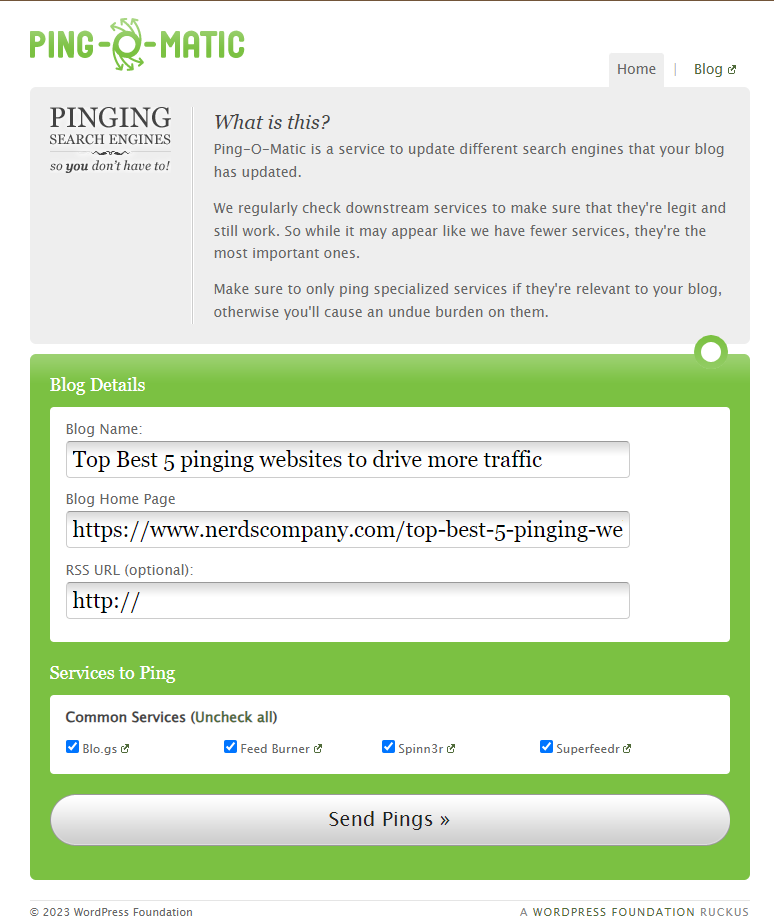
Pingler is our top choice that notifies Google search engine country extensions about the updated content on your page, such as blogsearch.google.com, blogsearch.google.ae, and so on.
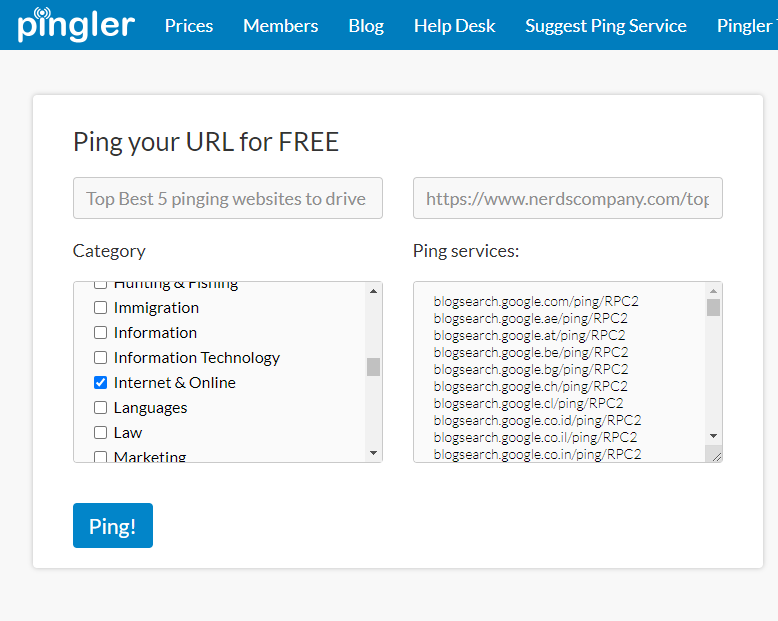
No matter what tool you choose, they all work the same way. You need to type the URL and select the category. Some of them require you to type the title.
Here are some top free tools to get started with.
If none of the above free methods can’t index your backlink, you have to look for indexing tools that’ll cost you some money.
From profile links to Web 2.0 to guest posts, they can help all your links get indexed with different complicated methods.
Here are the top indexers to consider:
5-A: Indexification
Indexification has been in the link building industry for 11+ years with 600k+ happy customers that indicates how effective this tool is.
You can submit unlimited URLs – as high as 50k links daily. It shows you real-time live crawl tracking and the state of your links. You have to pay $17.97 per month.
5-B: One Hour Indexing
One Hour Indexing comes next on our list. For $17 per month, you will be able to submit 1k links per day. Its fully automated service can start indexing your inbound links in just a few minutes.
5-C: Speed links
Speed links charge $9.99 for indexing 500 links. You can check the full progress and get the URL archives. It has many VIP plans. If you have a mega list, you can try its 100k links per day package for $699.99 per month.
5-D: Omega Indexer
Omega Indexer uses a new indexing method based on Google Search Console. While other indexing tools start indexing from the very second you submit the list, Omega takes 7-8 days. In their defense, they claim that they use safe and authoritative sources to index external links.
Omega Indexer charges by link credit. 1 credit = 1 link = $0.02. That means you will need only $2 to submit 100 links. However, you need to deposit a minimum of $20.
All of these indexing tools work the same way –
Before applying any method, you should focus on creating quality content and posting it on trusted websites relevant to you.
For your information, Google has no mention of force indexing and it’s not clear if they see it positively or negatively. However, if you follow Google’s SEO fundamentals, they will crawl at their own pace.
Here are some important guidelines you should follow (We assume you want to index guest posts.)
So, although you’re posting on someone else’s site for a backlink, you should still focus on creating original and highly informative content.
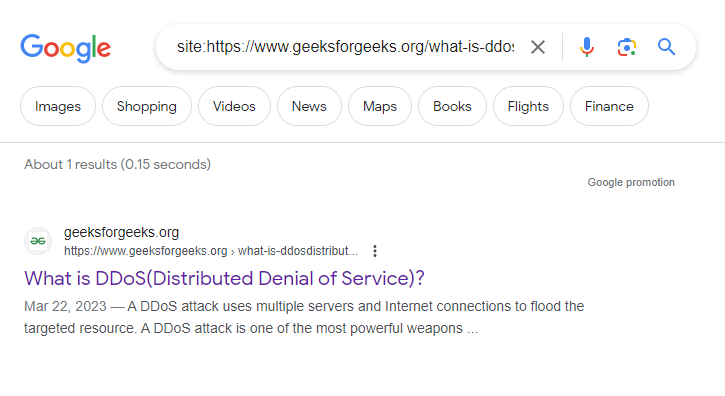
If you see the target page appear on the search result, that means it is indexed. On the other hand, if you can’t see it, that means it’s not there yet.
Are you struggling to gain valuable backlinks from high-authority sources? Do you need professional help to build your backlink profile and strengthen your SEO?
LinkBuilderPros.com is there for you.
We are a full-fledged link building agency specializing in white-level SEO. Our proven strategies, experienced team, and a track record of successful results set us apart in the industry.
If you are not happy with your link building campaign or want to launch one from the ground up, get in touch with us. Our specialists will reach out to you with a custom solution!
Backlinks will help with increased online visibility and ranking if they are fully indexed only. If Google can’t find them, you won’t get any SEO benefits. So, it is essential to invest time and effort to index your links.
In this post, we have explained several highly effective methods to index your links quickly. Follow them one by one and find out which tactic works for you better. Also, wait patiently because often, indexing takes time.
However, it’s not guaranteed that these steps will bring you good results overnight. Also, make sure you have followed the best practices while gaining links.
We hope this article will answer your question on how to index backlinks thoroughly.
Q. How long do backlinks take to get indexed?
Ans: Google takes around 3-7 days to index new backlinks. However, the timeline depends on the source site’s indexing ratios, authority, and content publishing frequency.
Q. Why are my backlinks not indexing?
Ans: If your site or the source website is new, it will take longer than usual to index your links because Google usually crawls old sites frequently.
Another reason could be no or fewer incoming links. The more inbound links you have, the more web crawlers will visit your links.
Also, Google warns about getting links from low-quality, spammy, or suspicious sites. Avoid them at all costs.
Q. What is a backlink indexing tool?
Ans: A backlink indexer or indexing tool refers to a dedicated tool that submits, signals, or notifies search engines about updated web pages to crawl and index them quickly.